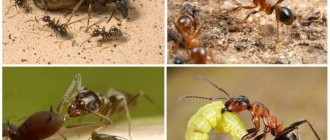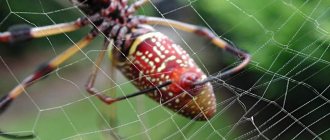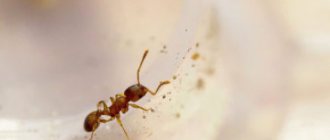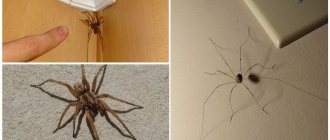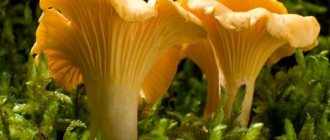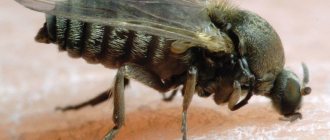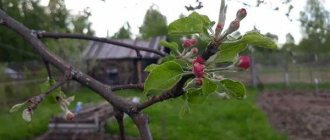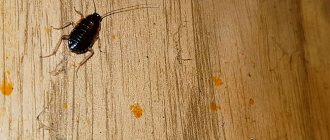Preface
If you ask most people what they understand by the concept of an anthill, then most likely the most popular answer will be in the form of a visual image of a large ant mound in a forest densely populated by ants. What is noteworthy is that those who have never interacted in any way with these anthills are sure that the same ants live there as in cities. And many people consider the winged ants that fly out of their nests during the mating flight to be a separate species of ants. That's what they say - these are winged ants that, in addition to moving on the ground, can also fly. If you are one of those who are still confident in this, then this video will be doubly interesting for you. And so, enough of the prefaces, it’s time to move on to the most interesting part.
Taxonomy
The hills that you could see in forests and even city parks are nothing more than the home (scientific nest) of a forest ant. Which proudly belongs to the genus Formica. This genus contains more than 170 modern species and is divided into clear 8 subgenera. Today we will talk about the most striking and numerous representatives of this genus: Formica rufa (red wood ant), Formica polyctena (small bare-backed wood ant) and Formica pratensis (meadow ant). In 99% of cases, you saw their anthills in forests, squares and meadows. It is important that you understand that despite the similarities of the first two species (Formica Rufa, Formica Polyctena) associated with belonging to the same subgenus and habitat, ants have a number of important differences, which we will definitely touch on.
Family and Colony
Ants are social insects - this word contains great meaning and the key to their long existence on our planet. According to some studies, this is more than 40 million years.
Social means that they live in large communities (families), from several tens to a million individuals. At the same time, insects are involved in collective actions that are aimed at maintaining the life and interests of the entire community. At the same time, ants are so adapted to life in a family that they are simply not capable of living outside it; in fact, it is the family that can be considered a kind of super organism, and individual individuals are its constituent elements.
The main pillars of every family are:
- Segregation of duties . Yes, with ants, like with people, everyone is busy with their own business. There are food getters, there are those who store it in pantries (storages), there are builders responsible for the formation of the hill, there are nannies who look after the queen (queen) and her offspring (eggs, larvae) and many others. Moreover, the family has the ability to redistribute the number of members of each of these groups. For example, if for some reason a nest (mound) collapses, then a large number of workers who were not previously included in this group of responsibilities will be assigned to repair it. And he will remain in this group until the restoration work is completed.
- The second pillar is information exchange . Ants communicate with each other no worse than humans, using the language of chemical and tactile signals, as well as sign language. By exchanging information, each ant knows what is happening in the family and in its area of responsibility, and finds out whether it now needs anyone's help. We should not forget the importance of trophallaxis (the process of transferring food and gland secretions from one ant to another), as a result of which not only food is exchanged, but also information that further regulates the behavior of individuals in the family.
- The third pillar is the importance of the social component . Numerous experiments have proven that two individuals live much longer than one, and the maximum life expectancy is achieved in groups of at least 10 individuals. As the group grows, labor productivity also increases.
Given favorable living conditions, ant families grow so large that one nest can no longer accommodate the entire population. Then colonies are formed. Entomologist Trout gave the following definition of colonies: “ A colony is of ants living simultaneously in several anthills. This definition implies a constant exchange of individuals between populations of different nests. It can be carried out either continuously or periodically.
Some of those already knowledgeable in this topic have noticed that in the vocabulary of myrmikeepers (those people who keep ants at home), for some reason a queen with 2 workers is already being called a colony. Which, by definition, as you understand, is considered incorrect.
Let's continue. The Formica Rufa anthill most often represents a family with a single fertile female. This female at one time left the nest in which she hatched, made a mating flight, mated with a male, shed her wings and, finding an anthill of another species - for example, Formica Fusca, penetrated it, killed their queen and took her place. Formica Fusca worker ants began to feed the young female rufa and raise her brood. Thus a new anthill arose, but Formica Rufa. Despite the fact that the family is represented by one anthill, it can grow to a million individuals.
At the same time, living mainly in dark spruce forests, but often also in pine forests, the smallest Formica - they are given the name Formica Polyctena - usually live in branched colonies: the family is spread out in several nests, interconnected by above-ground and underground passages and roads. In such a family there is not one, but hundreds, often even thousands of fertile, egg-laying females.
It is not surprising that polyctene anthills grow much faster than rufa, and form settlements with hundreds of thousands of inhabitants. These families willingly accept young females returning after the mating flight, whether they are their own or someone else’s, as long as they are of the same species. Coming every year to replace the old ones, they partially rejuvenate the family, so that it does not seem to grow old. Indeed, these anthills are extremely durable: they sometimes live for almost a hundred years or more, remaining invariably strong and viable.
Another striking example of family expansion: in Switzerland, Formica Exsecta ants form colonies of up to 200 nests.
When the nest becomes crowded, the queen and part of the workers (called the column) leave the nest and form a new anthill. The nest is built at such a distance so as not to create competition in obtaining food and at the same time there is an opportunity to exchange information and individuals within the colony.
Worker ants
This is the largest group of inhabitants of the anthill. The first ones to appear after the queen lays the first chamber of the future anthill are the builder ants. He expands and strengthens the future underground kingdom, takes care of future offspring.
Worker ants are divided into several subgroups within their group. Who performs what duties depends on the individual qualities of each insect. For example, individuals with proactive inclinations and reactions become hunters or scouts. The more sedate ones graze and spread aphids to plants and collect their sweet honeydew. The change in activity can only be influenced by age, when the old ant is no longer suitable for reconnaissance or hunting, or the sudden death of most of the colony.
Young specimens work underground, inside an anthill. They build new cells, dig passages, and care for larvae and females.
They say about some people: “Works like an ant.” And it does not mean that the result of his work is microscopic. On the contrary, it is praise denoting a gigantic job done alone. The comparison with insects is not accidental. Few in the animal world can boast of such strength and endurance. The little ant is able to lift and carry weight 50 times its own!
And if several insects join forces, the number increases to 70-80! This is because the ant's body structure is dominated by muscle tissue. Considering the size of the anthill and the number of “freeloaders” that the worker ant provides with food, it is clear that it is not at all superfluous in strength. A stubborn insect, if unable to lift and carry large prey, will drag it along the ground behind it until help arrives.
Surprisingly, when an obstacle appears on the way, the ants cling with their paws and form living bridges up to several meters long. This is usually necessary to overcome a stream, a crevice, or any place where it is not possible to walk on the ground. So, such a bridge can withstand a load of several kg.
Nest
There are a number of modifications to this typical structure. At the base of many wood ant nests lies an old worn-out stump, which the ants cover with various building materials, eventually forming a mound. In Formica truncorum in Europe, especially in small nests, the outer part of the nest is almost entirely contained in a stump, to which a small amount of plant debris is brought.
The most complex nests are those of red wood ants (Formica rufa). There is a deep funnel in the center of the nest. This funnel contains an “inner cone” of large, up to 10 cm long and 3-5 mm thick, sticks. In the “inner cone”, as a rule, the development of young ants occurs. The so-called solarium. The top of the nest is covered with a thick outer dome of small twigs, needles, leaf petioles, thick grass stems, etc. The material of the nesting mound of red forest ants, as shown by experiments with dyeing needles, is constantly mixed. From outside, workers bring in plant remains, but their quantity is generally insignificant. The ants constantly lift up fine nesting material from the inner parts of the outer dome. Large branches fall down, but due to their bulkiness they cannot be lifted up. This creates an “inner cone”. Constant circulation of nesting material prevents it from molding.
Surely many of you have wondered why ants build dome-shaped nests. Indeed, this form is not accidental; it allows the ants to make full use of the energy of the sun's rays to regulate the temperature in the anthill.
An object heats up best in the sun if the rays hit it at right angles. Therefore, at noon, when the sun is at its zenith and the rays hit the ground vertically (perpendicular to the ground), it is hottest. And in the morning and evening, when the sun has not yet risen sufficiently, the rays fall on the ground at an angle and heat (transmit energy) worse, although the sun shines with the same intensity both in the morning and at noon.
The dome-shaped shape of the anthill “catches” (all the time at a right angle) these morning and evening rays - warming the anthill. And at the same time, this shape of the anthill prevents the anthill from overheating at noon, when the sun is at its zenith - the rays fall on the dome at an angle, and do not heat it up so much. In Russia, sometimes there are giant anthills, one of them was found in the Tomsk region, it has a height of more than 2.5 meters and a diameter of more than 5 meters.
The passages of ant nests go to a depth of 1.5 meters, so that the ants can comfortably withstand the onset of cold weather. And the total length of the corridors can reach 100 km.
Another important point: The height and volume of the nesting dome on an anthill do not always reflect the strength of the family and give a correct idea of its age.
It is more correct to judge the population size of an anthill and its age by the condition and length of ant roads and the intensity of traffic on these roads, but, of course, taking into account other related circumstances.
Enemies and protection of ants
Ants have many enemies. Some of them penetrate inside the anthill, stealing supplies and eating the offspring. In addition to internal enemies, ants have many external ones. Thus, brown bears love to feast on these insects. Birds, wasps and predatory flies also feed on ants; lizards, moles and toads eat them. And in the tropics, anteaters feed on ants.
Giant anteater native to South America
The giant anteater is a large animal: its length including its tail reaches 230 cm. An elongated muzzle and a long, 60-centimeter tongue help it in hunting. When an anteater sticks its nose into an anthill, it begins to quickly work with its tongue: in one minute, the tongue protrudes and retracts 160 times. And since the anteater's saliva is sticky, ants stick to it - so it can eat about 30,000 insects per day.
Another enemy of ants is the antlion. This beautiful insect, similar to a dragonfly, feeds on pollen, and the enemy of ants is its larva. She makes a funnel out of tiny grains of sand, and she hides in its neck. An ant that lands on the slope of a funnel inevitably rolls straight into the lion's mouth.
Predatory antlion larva
Antlion trap in sand
However, ants do not always give themselves offense. They know how to defend themselves using poison - formic acid. With their jaws they can even bite through the skin of a person or large animal. Ants also know how to pretend to be dead in case of danger. But the main defense of ants is their number. Even after a fire, several ants remain alive.
Self-test questions
- Why are ants harmful?
- How are ants useful?
- Which animal is a “cow” for ants?
- Why was an insect similar to a dragonfly called an antlion?
Segregation of duties
As noted earlier, in a family of ants, each individual performs certain functions, i.e. there is a strict separation between them. Males perform only functions related to reproduction. After fertilization they die. The functions of females vary over time. At the beginning, after fertilization, the female looks for a nest. Then, as a rule, she starts a new family and raises her first offspring. In a family, the fertile female, or “queen,” performs only one main function—reproduction. Workers take care of the offspring. By the way, workers are also females, but to put it mildly, underdeveloped. They have no wings and a poorly developed reproductive system.
Observations of the anthill showed that there are the following types of work performed by permanent groups of workers:
- Caring for aphids and collecting honeydew (we'll talk about this later)
- Collecting building material and hunting. It is performed by the same workers
- Carrying workers
- Exchange of brood between nests
And what is noteworthy is that the largest and strongest individuals are engaged in hunting and collecting building material, while the medium and small ones go to collecting honeydew (sweet secretions of aphids).
Further we will not talk in detail about the processes occurring in the nest, because this will require a whole series of videos, especially since most of the processes are similar to other genera of ants, and we want to talk specifically about forest defenders.
Queen of Ants
The queen of the ants is the queen, a sexually mature female.
She needs wings, in fact, only to find a male. Males and females of ants fly quite poorly. Ants are not able to fly directly from the ground. They rise gradually, first flying onto blades of grass, then onto branches of bushes, then trees, and only then, from a sufficient height, they begin to fly. However, some drones are capable of taking off directly from the ground. After fertilization, the female sheds her wings - she no longer needs them. The queen is capable of founding a new anthill. To do this, she digs out a small underground corridor, where she subsequently lays eggs. Sometimes several females organize a colony at once. After this, a difficult period begins in the life of the uterus. Until her daughters grow up, she has to starve while feeding the larvae. But when the first workers appear, she will begin to live like a real queen: her daughters will provide her with a well-fed existence. By the way, it is interesting that males hatch from unfertilized eggs.
Occupied territory and feeding area
Like developed predatory animals (wolves, tigers, lions, etc.), which look after their possessions, leaving marks to warn uninvited guests of the same species, each forest ant colony or nest separately also has the concept of occupied territory, which has clear boundaries. The establishment of territory boundaries occurs annually after the spring awakening of ants. For example, in the climatic conditions of the Moscow region, this occurs from mid-April to the end of May. At the same time, on the borders of the territories of nests of different species, one can constantly observe “fights” between ants, leading to the death of a significant number of individuals of both anthills. By mid-July, more or less permanent boundaries are established, and “collisions” between individuals of different species, as a rule, are not observed.
While studying the territories of forest ants, entamologists discovered a curious phenomenon. In some studied species (F. rufa, F. polyctena, F. truncorum, F. exsecta), workers carry the remains (more precisely, one chitin) of eaten insects to the border of the territory and throw them away there. In this case, the worker moves straight, reaches the border, leaves the burden and returns to the nest in the same straight line. This shows that the ants somehow (most likely by smell) sense the boundary of the territory. In the same way, a worker who enters someone else's territory, after walking a few centimeters, turns back, even if he does not encounter individuals of another species.
The area processed by ants is called a feeding area. Most often it coincides with the occupied territory. As you understand, ants do not go where there is no food, without wasting their energy. The size of the feeding area depends on the size of the family, the amount of food and its placement. The feeding plot of one family, depending on the size, can vary from 100 to 1600 square meters. With a sharp increase in pests, the size of the feeding area shrinks and expands only when the family begins to cope with the destruction of pests on it and it needs new feeding areas.
Food detection
Ant trails are roads along which ants move to the main feeding areas and diverge from the nest in different directions. There may be 3-5-10. Again, depending on the size of the family itself and the placement of food in a given area.
The trails go from the anthill to a distance of up to 250 meters. Some of which remain unchanged for 8-10 years or more. Hundreds of thousands of foragers (scouts) run along the trails, scratching every corner of the forest. Having found a source of food, they return to the nest, while using chemical and tactile signals to inform other individuals in their group about the presence of food in a particular area, and even its quantity. And after some time, hundreds or even thousands of hunters mobilize, heading to the found source of food.
These hardworking insects
Black, red, red ants belong to a family of insects that belongs to the superfamily Antidae from the order Hymenoptera, which also includes wasps, bees, ichneumon wasps, sawflies and gall moths. In total, there are more than 13 thousand species of ants, most of which live in tropical latitudes (for comparison: 1,150 species live in the Palearctic, about three hundred in Russia).
The number of this family, according to various sources, ranges from 10 to 25% of the biomass of all terrestrial creatures. True, their weight is extremely small. For example, in the Amazon forests there are 800 million ants per square kilometer, while in total all forest ants weigh half as much as the rest of the inhabitants of the area.
Red, black and red ants are distributed throughout the world. It is worth noting that not only forest and garden ants, but also ants in the house are a common occurrence. They are not found except in cold Antarctica and several islands located far from the continent.
Insects build anthills wherever they can, using mainly soil and plants for construction. Their nests can be seen everywhere: on the ground, under stones, in logs, underground; if they happen to settle in a house, they can build an anthill there too. An anthill should never be built in areas with dead insects, as this indicates the presence of disease or other danger.
Such good adaptability is largely due to excellent social organization, the ability to use various resources and maneuverability in their life: if necessary, they will easily change their place of residence.
Terrain orientation
When searching for prey and when returning to the nest, ants must be well oriented in the area. Formica's main method of orientation is light-compass orientation, despite the belief of many myrmikeepers that all ants move exclusively along the chemical trail left behind. Now know that not everyone. An explanation was obtained when the scientist Vaules, using the example of Murmica rubra and M. ruginodis, showed that ants, like bees, are able to see the direction of polarization of light. In simple words, ants can navigate by the sun.
It has also been proven that ants have a sense of time, thanks to which they make allowances for its movements during the day. This is not the only orientation mechanism. If there is no sun, then other orientation methods come into force: by polarization of the blue sky, as well as by ground landmarks. All this is necessary so that the ant can return to the nest, even if the path is mechanically destroyed or in the case when it develops a new territory for the nest.
Hunting
Hunting is perhaps one of the most important processes in the life of forest ants and, of course, in the life of the forest. Therefore, we will stop here for a long time. One family, depending on its size, completely protects a forest area from 1 to 12 hectares from damage. Do not forget that ants also rise to a height of 5-7 meters. Therefore, the total pasture space is one million cubic meters. So it turns out that one large family can single-handedly clear an area of forest equal to the area of Zaryadye Park in Moscow. As a result of observations, scientists found that 4-6 medium nests are enough to protect a forest of 1 hectare.
Here are some more numbers for you: in 1938, in the Moscow region, ants from one average nest destroyed about 7,200 caterpillars per day, and later, after pupation, also pupae of the pest. The extermination of the latter lasted about 20 days, and during this time more than 10 thousand pupae were destroyed. When the butterflies began to emerge, the ants switched to feeding on them, and caught them mainly at the moment they emerged from their pupae. Over 30 days of summer, more than 150 thousand adult butterflies were destroyed.
For those who are not yet impressed, it is worth citing another interesting calculation concerning the ants inhabiting the forests of Northern Italy. Here, on an area of over half a million hectares of forest, about a million anthills were registered. The total weight of the ants in these nests, according to experts, was approximately 2,400 tons, and the average weight of food eaten daily was 120 tons. In two hundred days, while the active life of anthills lasts in this strip, their inhabitants destroy 24 thousand tons of insects, of which at least 15-16 thousand tons are living pests. To give you an idea of the scale, these are 214 railway gondola cars loaded to capacity.
Formica prowling in search of prey, when necessary, attack the prey together, prevent it from escaping pursuit, gnaw it with its sharp mandibles, spray it with acid, and if it happens on a tree, throw it to the ground, and here other hunters take over it. Driven away by the convulsively wriggling large caterpillars, the ants retreat, but later, when the victim, sprayed with acid, weakens, they return and resume the attack. The first to be attacked are the most noticeable ones - especially mobile insects, later the turn comes to the less noticeable ones - sluggish ones, completely motionless ones often go unnoticed.
Observations have shown, as has already been briefly mentioned, that most of all, hunter ants destroy precisely those pests that have multiplied too much and therefore pose a particular danger to the forest.
Such an ability is infinitely valuable - to curb, restrain, and therefore prevent outbreaks of especially dangerous pests. That's why destroying an anthill is like leaving a time bomb in the forest! Sooner or later, the mine will go off, and then the remains of a frozen anthill will be surrounded by the naked dark skeletons of dying trees.
What else is important to note. Red forest ants - despite the above facts, are not universal killers of all pests in their path. Unfortunately, they cannot reach stem and subbark pests, such as bark beetles (Scolytidae), but they can eat their parasites.
Thus, by protecting stem and subbark pests, they increase their population, thereby, indirectly, increasing the number of birds that feed on these pests. For example, in Germany, after 800 hectares of forest were artificially populated with 850 nests of red wood ants, the number of woodpeckers increased 5 times.
Let's summarize
The list of forest pests that Formica ants do not disturb and cannot cope with is still quite large, so forest ants cannot be seen as the only salvation from all the misfortunes that the harmful entomofauna threatens the forest with. However, from some representatives of this fauna, and, it must be said, not from the most harmless ones, Formica ants are able to protect some forest species, and also by no means insignificant.
Internal structure
Ants are insects that are considered one of the most famous and numerous in the world. Ant size and weight vary depending on the species. Body length can range from 1 to 50 mm. And more often than not, the largest ants are also the most dangerous in the world. Moreover, females are usually much larger than males. Body color depends on the species.
The anatomy of an ant is quite complex. The body of the murash is covered with a chitinous shell. This kind of skeleton not only supports, but also protects the baby. The description of the appearance of different representatives is almost similar. Head, chest and abdomen - this is the structure of the ant. A photo of the ant can be seen below.
Ant close up
Head
The head of an ant is usually large in size; for each individual species it differs in a certain structure. It has powerful mandibles. With them, workers carry food, blades of grass and twigs used for building nests. Mandibles also help insects defend themselves.
The mouthparts of an ant are of the gnawing type. It includes the jaws, which are also called mandibles or mandibles, the upper lip (labrum) and the lower lip (labium). The mandibles can be large or not very large, excessively sharp or completely blunt. They are also overlapping and interlocking. Thanks to this feature of ants, mandibles can chew food even with their mouths closed.
The organ of taste for goosebumps is the tongue located on the lower lip. Insects also use it to clean their bodies.
The sensory organ of insects is the geniculate antennae. They help ants detect odors, detect vibrations and vibrations in the air. In addition, insects use this organ to receive and transmit signals during communication with their relatives.
Abdomen
The abdomen of ants is stalk-shaped (the stalk is formed by one or two rings). There may be a vertical growth or notches on it. Some varieties of ants have a sting at the end of their abdomen, which serves as a tool for hunting and their defense. Thanks to it, insects secrete acid - a special substance that paralyzes the enemy.
Ant body
The method of their movement depends on the structural features of the insects' paws. Not all ants move on foot; some species have the ability to jump. There are also gliding insects and runner ants, red fire ants are able to form bridges over water barriers.
The ant's legs serve more than just movement. So, with its front legs, equipped with special brushes, the insect takes care of its antennae. Spurs located on the hind legs are used for attack and defense. And the presence of small serrations on all legs allows insects to move even along steep, smooth surfaces. An example of this is pharaoh ants, which can run quickly on glass.
Nervous system
The insect nervous system includes several interconnected ganglia. Thus, the suprapharyngeal ganglion, which acts as a brain, is responsible for the thinking and behavior of insects. It is much larger in relation to the body. The working ant has a particularly large brain; in females it is slightly smaller, and in males it is the smallest.
The blood of ants is a clear liquid - hemolymph. It is driven throughout the body by the spinal vessel – the heart. It is a muscular tube that runs along the entire back.
Respiratory system
Respiratory system of tracheal type. The trachea opens outward through stigmas (spiracles), which are located on each abdominal segment (on a stalk at the base of the scale).
- The uterus is large in size. Before mating, females have wings, which they chew off for additional nutrition when they lay eggs. The queen's breasts are more powerful and developed, and her abdomen is wider.
- Males are significantly smaller than females. Most have wings, but there are also wingless ones.
- Workers are females who cannot have offspring. They are more modest in size than the uterus. They don't have wings. The structure of the chest is simplified, the eyes are smaller and may be absent.
- Soldiers are larger workers with a disproportionately large head and powerful mandibles that allow for effective defense.
Trophobiosis with aphids and its practical significance
Trophobiosis of forest ants with various species of aphids is one of the forms of animal symbiosis. A number of aphid species produce large quantities of high-carbohydrate excrements called honeydew or honeydew. Let us remember that carbohydrates are the main source of energy for ants, and as a result, their main food. Protein, in the form of killed insects, is needed for the younger generation (juveniles).
One family of forest ants, out of 100,000 individuals, collects about 10 kg of honeydew within 100 days. During the year, the Formica Rufa family collects an average of 450-500 kg of honeydew (or 90-100 kg of sugar). That's 2 full bags. Think about these numbers.
Ants protect aphid pastures from their natural enemies, transfer them to more suitable parts of plants, build galleries above them to protect them from enemies and direct sunlight, carry overwintering eggs and the aphids themselves to the nest when cold weather sets in, so that in the spring they can again spread them to the trees.
Someone has already thought that aphids harm trees, and ants are called upon to protect them from pests. What is the logic behind the behavior of ants?
As Kloft's research has shown, aphids living on trees can be divided into two groups: aphids sucking from the parenchyma and aphids sucking from the phloem. Representatives of the first group produce honeydew in small quantities and therefore are not used by red wood ants. Likewise, ants are not associated with waxy aphids. At the same time, almost all the main aphids that harm the forest belong to these groups. Red wood ants in forests use the secretions of aphids sucking from the phloem. This also includes representatives of the family Lachnidae (Lachnidae), preferred by ants in coniferous forests. The harm from these aphids, especially in comparison with species sucking from the parenchyma, is negligible. This has been proven more than once by scientists. But when assessing the ecological significance of a group, only one factor cannot be taken into account. As you know, the main damage from aphids on trees is often caused not by the fact that they suck sap, but by the fact that with their excrement they cover the stomata of the leaves and cause the spread of sooty fungus. Ants, by collecting excrement, prevent this danger. In addition, it should be borne in mind that ants primarily hunt precisely on those trees that they visit because of aphids.
The only truly serious danger in forests is represented by beech aphids (Lachnus (Schizodryobius) ppallipes (—L. longirostris, L. exciccator), guarded by red forest ants. These aphids cause degeneration of the cambium and the formation of bark cracks in beeches. In turn, this leads to Infection of trees with the beech canker fungus Nectria ditissima: on old trees, large branches die as a result, and young ones often die.Therefore, in beech and mixed (coniferous and beech) forests, red forest ants cause serious harm.
Aphids are also serious pests in gardens. Red wood ants, guarding these aphids, in particular the apple aphid Аhis pomi deg., can cause great harm in gardens and are, of course, harmful insects here.
Time to take stock
- In most forest biocenoses (excluding beech forests and, possibly, young forest plantations), forest ants play an invaluable positive role, as they destroy many harmful insects.
- Breeding aphids does not have a negative impact on trees, since under these conditions the ants breed and protect practically harmless species of aphids. Moreover, breeding by Lachnidae ants creates favorable conditions for the existence of other beneficial entomophagous insects.
- The soil-forming influence of an ant nest clearly extends horizontally within a radius of about a meter, and in depth to more than half a meter. According to agrochemists, ants significantly reduce the acidity of the soil, and, as geobotanists have recognized, ant nests change the composition of the vegetation covering the soil.
Ant guard
Unfortunately, it turned out that it is people who cause the greatest harm to forest ants. As a result of an unconscious and mismanagement attitude towards these beneficial insects, their number near large cities is falling catastrophically
Firstly: Anthills are destroyed by people walking and relaxing. They often enjoy sticking a stick into an anthill and seeing what comes out of it.
Secondly: ants are used to obtain “ant oil” for home treatment of rheumatism, and also as a means for hair removal. The greatest harm is caused to forest ants by the practice in some areas of burning anthills for ash to fertilize vegetable gardens and extracting ant eggs, i.e. ant pupae. Pupae are used to feed some songbirds and aquarium fish. Without it, it is impossible to breed pheasants in the central zone of the European part of Russia and Western Europe. As a result of such barbaric activity, red forest ants in some places completely disappear.
In 1996, along with 149 other species, Formica rufa and Formica polyctena were listed on the International Union for Conservation of Nature Red List of Threatened Species.
Friends, now you know without a doubt that forest ants are amazing creatures. They play an important role in the forest biocenosis, preventing outbreaks of mass reproduction of leaf-eating insects.
Take care of them, and do not allow other people to treat them barbarously. No matter what motives and goals they hide behind.
Main varieties of ants
Now we have been able to study approximately 13,000 species of ants, of which only 300 live in our country. One should take into account the fact that insects are difficult to classify. This is due to the fact that there are twin varieties and various hybrids; it is difficult to distinguish them from similar ones by their appearance. The most common and well-known ants include the following varieties:
- Black garden ant. This is the most common variety, its representatives can be found in Great Britain, Portugal and central Russia, as well as in the Far Eastern region, reaching Ulaanbaatar. Working individuals grow up to 4.5 millimeters in length, males reach 5.5 millimeters, and the size of females is slightly larger and amounts to 7.5-11 millimeters. Let's look at the description of the ant in more detail: the body is dark brown or black, and there are a large number of short hairs on its surface. These ants are able to make their nests under stones, in the ground, in old wood. The main product included in the diet is honeydew, which is secreted by aphids, resulting in serious damage to agricultural land as the ants raise and protect the aphids from their enemies. A distinctive feature of the species is the amazing lifespan of the uterus - it is a record 30 years.
- Red myrmica. This variety is widespread in the Urals, Far East, Siberia and European countries. Females have a reddish color, they are not very large individuals, since they can reach 6 mm in length, and males have a black color, their maximum length reaches 5 mm. They make their homes under stones, underground and lying trees.
- Small forest ant. Lives in a temperate climate zone in forests in the northern part of Eurasia, for example, in Spain, Germany, Belgium, Sweden, Finland and Russia. Wood ants can reach sizes from 7 mm to 14 mm, have red cheeks, a red-brown tint and a black belly. Often the anthill of these individuals can reach a length of about 2 meters; it consists of needles and branches. This species of ants has endangered status; it is listed in the Red Book of various European countries, and in some areas it even belongs to a rare species.
- Pharaoh ant. The homeland of this species is Egypt, but after some time the ants settled across all continents. Representatives of the working class are yellow in color, they have no wings, and their length does not exceed 2 mm. Males have wings that are almost completely black, and the length of the body is 3.5 millimeters. Females are brownish-yellow in color, their length does not exceed 4.5 mm, at first they have wings, but after fertilization, worker ants bite off their wings. Pharaoh ants preferably live in damp areas, and they build an anthill within the boundaries of one residential building in the foundation, walls, behind interior decoration, baseboards and even in closets with clothes and household appliances.
- Giant dipoponera. It is the largest ant in the world, its size is about 33 millimeters, and its body is completely black. This individual lives exclusively in the savannas of South America and humid forests; in these regions it was called the Dinosaur ant or the Amazonian Giant ant. A distinctive feature of the variety is the presence of males with wings and the complete absence of females. The last role is played by workers capable of reproduction; they are females. The housing of these ants is located underground, its depth is no more than 40 centimeters, it can accommodate all family members, and there are not so many of them - only 20-30 individuals.
Pharaoh ant
